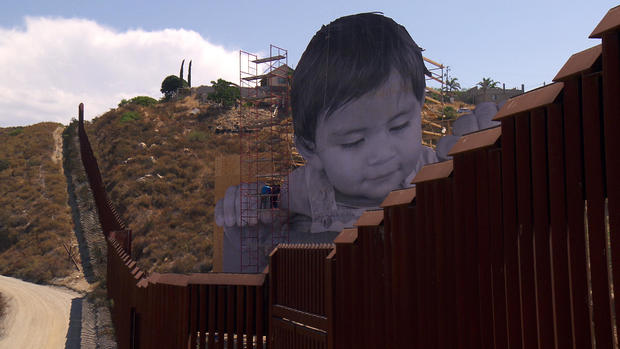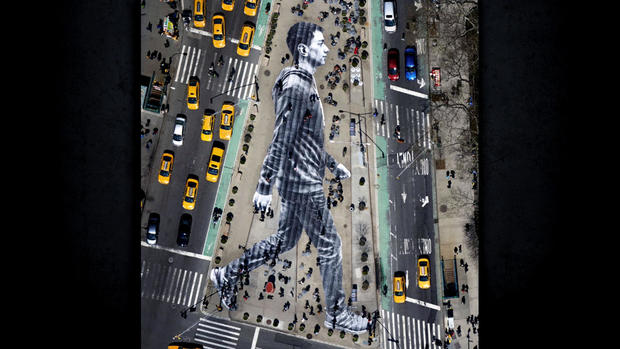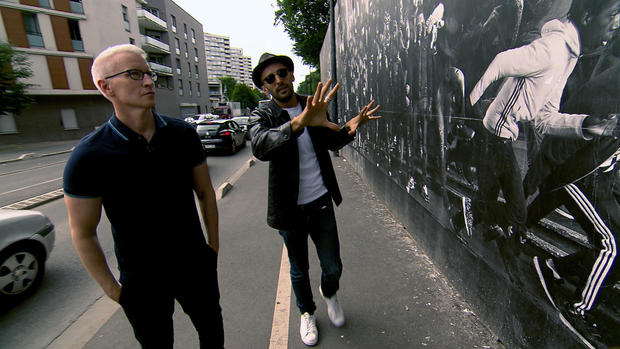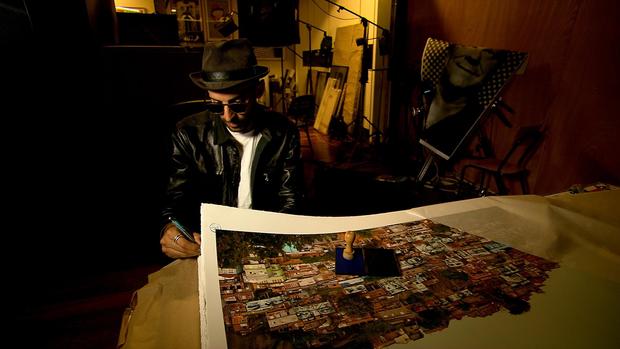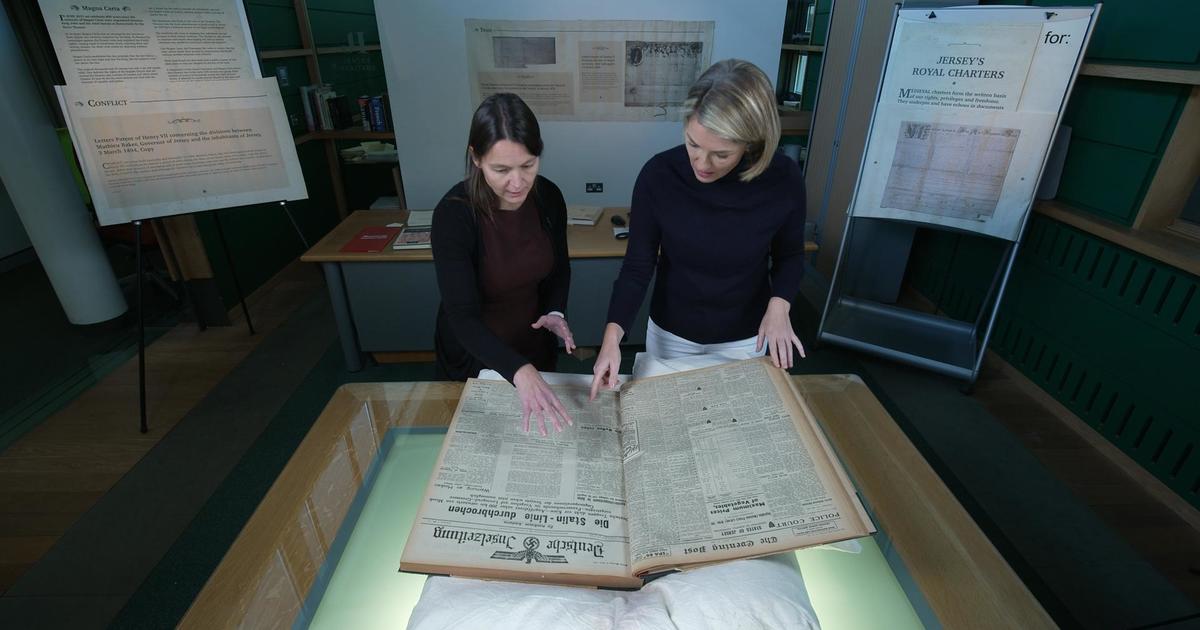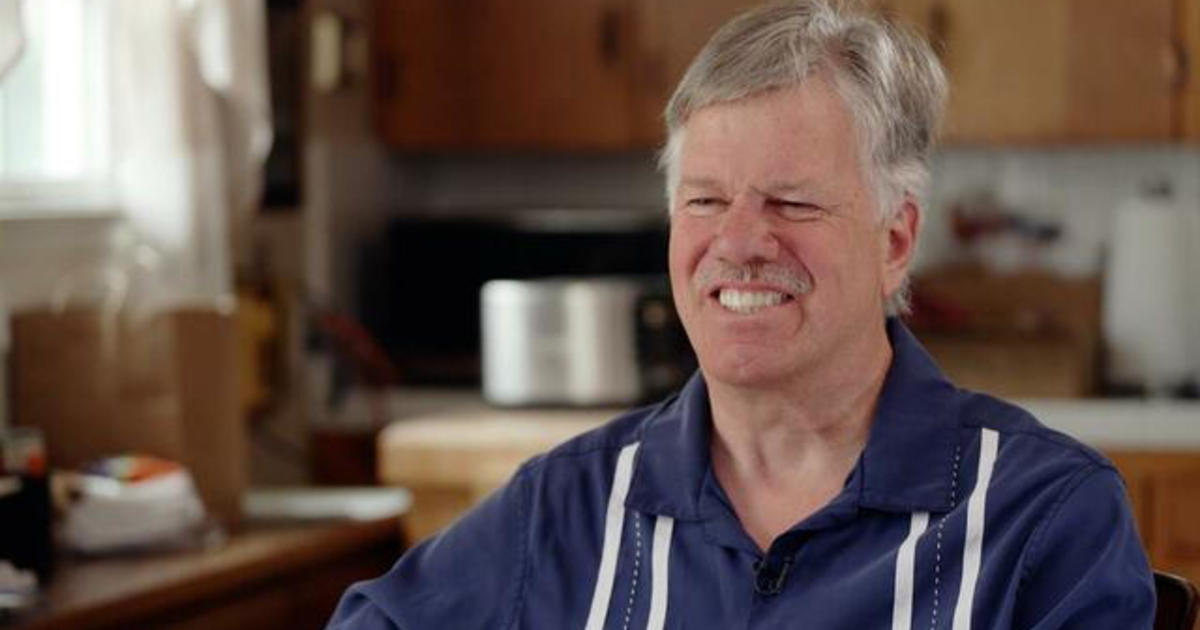Larger than life displays by French photographer JR
When a giant photograph of a child appeared looming over the U.S./Mexico border near San Diego almost two years ago, art aficionados knew right away it was the work of an artist who calls himself JR. You may never have heard of JR, but his giant photographs have appeared in some 140 countries, sometimes in fancy art galleries, but more often than not pasted illegally on sidewalks and subways, buildings, and rooftops. Plenty of famous artists like Basquiat and Keith Haring started off scrawling their work on the streets often in the dead of night, but, as we first reported last year, few have continually displayed their art in public spaces on the scale of JR.
This is the photograph that popped up in September 2017 along the U.S.-Mexico border. A 64-foot tall picture of a Mexican child named Kikito who lives just on the other side of the fence -- built on scaffolding on Mexican soil, there was nothing U.S. border patrol agents could do about it.
It was classic JR, a person's picture, pasted in a public place, that made everyone stop and stare. JR's been doing this kind of thing all over the world for the past 15 years. He put the faces of Kenyans on rooftops in a Nairobi slum. In Cuba, where oversized images of Castro and Che are the norm, JR put up enormous pictures of everyday people. On New York sidewalks, and Istanbul buildings, in Tunisia during the Arab Spring in a looted police station. JR has pasted his pictures, often without permission, and at risk of being arrested.
We met up with JR in a suburb of Paris in front of a giant mural he'd made out of photographs of more than 700 local residents. We don't know his real name and that's just how JR wants it. In public he never takes off his glasses or hat, there's a practical reason for it, but a little mystery also builds mystique in the world of art. What we do know is that JR is 36 years old and was born in France, the child of Tunisian immigrants.
Anderson Cooper: I don't think I've ever done an interview for 60 Minutes when I didn't actually know the name of the person I'm interviewing. You're not gonna tell me your name?
JR: Would it help, you know? I mean, in a lot of countries--
Anderson Cooper: It would help me.
JR: In countries where I got arrested, you know--
Anderson Cooper: It's important for you to be anonymous?
JR: Yeah, because unfortunately when I travel in lot of other countries where what I do, just paper and glue, is not considered as art, I get arrested, deported, put in jail--
Anderson Cooper: What-- what's art in one country is a jailable offense in another?
JR: Exactly.
JR's been committing jailable offenses since he was a teenager. He says he was repeatedly kicked out of high school and would sneak out at night with friends, spray painting graffiti in hard to reach areas.
Anderson Cooper: Graffiti or tagging what was the appeal of that?
JR: We all have that sense of, "I wanna exist. I wanna, like show that I'm here that I'm present."
Anderson Cooper: Graffitiing was saying, "I am here." "I am a person."
JR: Exactly, "I'm here. I exist."
His foray into photography began, he says, by accident.
JR: I found a camera in the subway. Yeah, a tiny camera.
Anderson Cooper: You really just found it?
JR: Yeah, no it's true and it's funny, 'cause a lotta friends tease me, "Yeah right, you started your career-- stealing a camera."
Anderson Cooper: I'm not sure the police would believe that story, but --
JR: I know, but you know, I --
Anderson Cooper: Some things are true?
JR: Exactly.
JR: And at some point, I realized I was not the best in graffiti, you know? I had the balls to climb any building you want, but I would not do the craziest piece. But I was with friends who were amazing. Then I realize, "Wait, let me document the journey."
Anderson Cooper: The journey of it?
JR: Yeah, so I went from "I exist" to "they exist," and I realized the power of that.
Anderson Cooper: Once photography got into the picture it was about these other people exist?
JR: Exactly--
Anderson Cooper: They exist.
JR: They exist.
Many of JR's friends in this Paris suburb whom he began taking pictures of, felt they didn't exist in the eyes of French society. Most of those who live in this neighborhood are of African or Arab descent, first or second generation immigrants. And few wealthy Parisians ever venture here.
In 2005 riots broke out in this neighborhood after two kids died while being chased by police. The violence spread across France. JR saw how the young people in this suburb were being portrayed on television and decided to use his camera to tell a different story.
JR: You would see the riots, everyone had hoodies. And then so any kids coming from the suburb would look like a monster to you. so that's when I started photographing them from really close and I said I'm gonna put your name, your age, your building number on the poster, and I'm gonna paste it in Paris where they see you as a monster. And actually, you gonna play your own caricature."
Anderson Cooper: Why play your own caricature? Isn't that feeding a stereotype?
JR: It's actually--by feeding it, it breaks it and I wanted them to be in control of their own image.
Anderson Cooper: And you wanted people in Paris who maybe had never been to this neighborhood to understand what?
JR: The humanity. When you look at those face it makes you wanna smile by playing the monster, they don't look like monster anymore.
JR enlarged the pictures and printed them out and with friends began pasting them up illegally at night around Paris. Most were immediately taken down, but the mayor of one Parisian district gave JR permission to paste them on a wall outside a museum. It was JR's first official public art exhibit. He was 23 years old.
JR: The people from Paris would go in front of those pictures and take a photo of themselves with them. And people were trying to find who is who and get a photo with them, where they're supposed to be the monsters that are about to invade Paris. So it kind of break the tension that there was.
The idea of breaking tension through photography was a revelation to JR. In 2007 with money saved from odd jobs he decided to head to Israel. It was after the second intifada, and his plan was to paste photographs on the wall separating Palestinians and Israelis in the west bank.
JR: So I started making a list of people doing the same job on each side: hairdresser, taxi driver, security guard, teacher, student. And then I would go and I would say, "Look, I wanna paste you playing your own caricature of how the other sees you, but I would paste you with the other taxi driver."
JR: "Oh yeah, sure. Yeah, take my photo. But the other guy, he is never gonna accept. They're c-- really close-minded. They're never gonna accept." And when I go there, same thing.
Anderson Cooper: Each person on each side said, "I'll do it, but the person on the other side won't do it--?"
JR: Exactly.
Before he could begin pasting the photographs, JR and his team were arrested by Israeli authorities for not having a permit. They were loaded into the back of a wagon and hauled off to jail. After some questioning, they were released and given 15 days to leave the country. Instead, JR went to the Palestinian side of the wall and began to paste.
JR: I paste a giant photo of the taxi driver and the second photo of the other taxi driver. And you know, a crowd of people very quickly, big crowds. And then the first guy asked the question. 'But my friend, who is this people?" I say, "oh, one is Israeli and one is Palestinian. And then you have a big silence on the crowd. And I say, so who is who? And they couldn't even recognize their enemy or their brother.
On the Israeli side, to ensure he wouldn't be arrested again, JR announced the day and time he was going to put up his photographs. He says so many reporters and onlookers showed up to watch the authorities decided to just let him go ahead with his project.
The attention he got from his work in the middle east and france led to some sales of his photographs... Which then allowed him to begin to travel further afield. Over the next few years in Kenya, Liberia and Sierra Leone, he focused his lens on women, heroes, he says, who are often treated as second-class citizens. He photographed women's faces, and placed them where they could no longer be ignored. A Kenyan woman named Elizabeth Kamanga asked JR to paste her picture for all the world to see.
JR: The woman ask me, "Make my story travel."
Anderson Cooper: Have my eyes, my story travel around the world.
JR: They want someone that they never heard of to hear, like sending a bottle in the water.
Her story did travel, thousands of miles around the world. Jr pasted her eyes onto a container ship called the Magellan that spent months at sea.
In 2008 he ventured into Providencia, the oldest favela in Rio -- a slum perched on a hillside controlled by a well-armed gang of drug dealers. JR photographed an eldery woman whose grandson was murdered by a rival gang. She agreed to let him paste her image on the stairs leading into the neighborhood.
Anderson Cooper: Did you have permission from any-- from the gangs, or--?
JR: No, from nobody. From nobody. We start pasting the stairs like that, great vibe, kids playing you know, we're just pasting on the stairs. After ten stairs huge, like, fights of gun. And like, it starts going from all over.
JR and his team were caught in crossfire between police and gangmembers.
JR: We run and we hide. Like it's the last day of my life. And the next day we came back and we kept on doing the stairs. And I think that what made the people in the community realize that, okay, we're not just here for a minute.
JR: And-- that first time when that woman was pasted on the stairs everybody in the community understand what the project was about. It was her, she was standing there straight and looking strong.
Her photo covered eighty steps and after that other residents allowed JR to post their faces and eyes on the sides of their homes. A display of strength and dignity, he says, that could be seen from the wealthier neighborhood below.
Anderson Cooper: That word dignity to you is important.
JR: You know the people made me realize it's important in every single pasting.
Anderson Cooper: Dignity is something that all of us want--
JR: All of us, anywhere--
Anderson Cooper: --no matter what, any walk of life--?
JR: --no matter the background.
Anderson Cooper: Why? Because the issues people are facing are life and death--?
JR: Yeah, of course. Dignity goes through the way we're being seen by the others, the way we portrayed ourself.
Anderson Cooper: I think some people hearing that are gonna say, "Look-- you're telling me that people, you know, who don't know where their next meal is coming from, are struggling to survive-- care about art?"
JR: You know what? Yes.
If you are wondering how JR pays for all these projects, so were we. He now has a team of about 16 people working for him, out of studios in Paris and New York. He doesn't like to give details of how much his projects cost, but some of the money comes from the sale of limited edition prints of his work. He doesn't accept any sponsorship from corporations, but he does have wealthy art patrons who help him out.
JR: There is amazing people out there. There is people that support me, there's someone that gave me a building to put my studio that I don't pay rent, so I don't have to look for sponsors. There are amazing people that I call the shadow philanthropists, the people who really wanna change--
Anderson Cooper: Shadow philanthropists?
JR: Yeah. And that don't look for return. They don't get into -- philanthropy to get more credit.
JR's work may focus on other people, but it's also made him a celebrity in his own right. He has more than a million followers on Instagram, and routinely is seen in the company of rock stars and other artists. A documentary JR directed, called "Faces Places", was nominated for an Oscar. Fame has its benefits, JR doesn't always have to sneak around now. He is often allowed to display his work. Last year on Ellis Island, in New York Harbor -- the National Park Service let him paste old photographs of immigrants at this abandoned hospital.
Anderson Cooper: And what does it mean?
JR: You know I just try to do art in places that it would raise questions rather to give answers.
JR is now encouraging others to raise questions by pasting their own photographs. He has a website where groups of people with an idea or a cause can send in their pictures, he says, he'll enlarge and print them, and ship them back. JR-inspired images have so far been pasted on walls in dozens of countries around the world.
Anderson Cooper: Are you still an artist if you're not taking the photo and you're just printing stuff up and sending it out to people, and they're putting it up?
JR: I don't know. I mean, I am. As-- I'm-- as-- much as a printer, then I'm a photographer, then I'm-- a wallpaper man. You know, that's what I do--
Anderson Cooper: You're a wallpaper man--?
JR: At the end of the day I-- I wallpaper buildings, you know? That's what I do. So that's why I think the title "artist" is the most prestigious title I'll ever get, because you know, the truth is I paste building.
JR's latest project, "Chronicles of San Francisco," opened in May in that city's Museum of Modern Art. The digital mural is JR's first exhibit in a major American museum.
Produced by Magalie Laguerre-Wilkinson.
